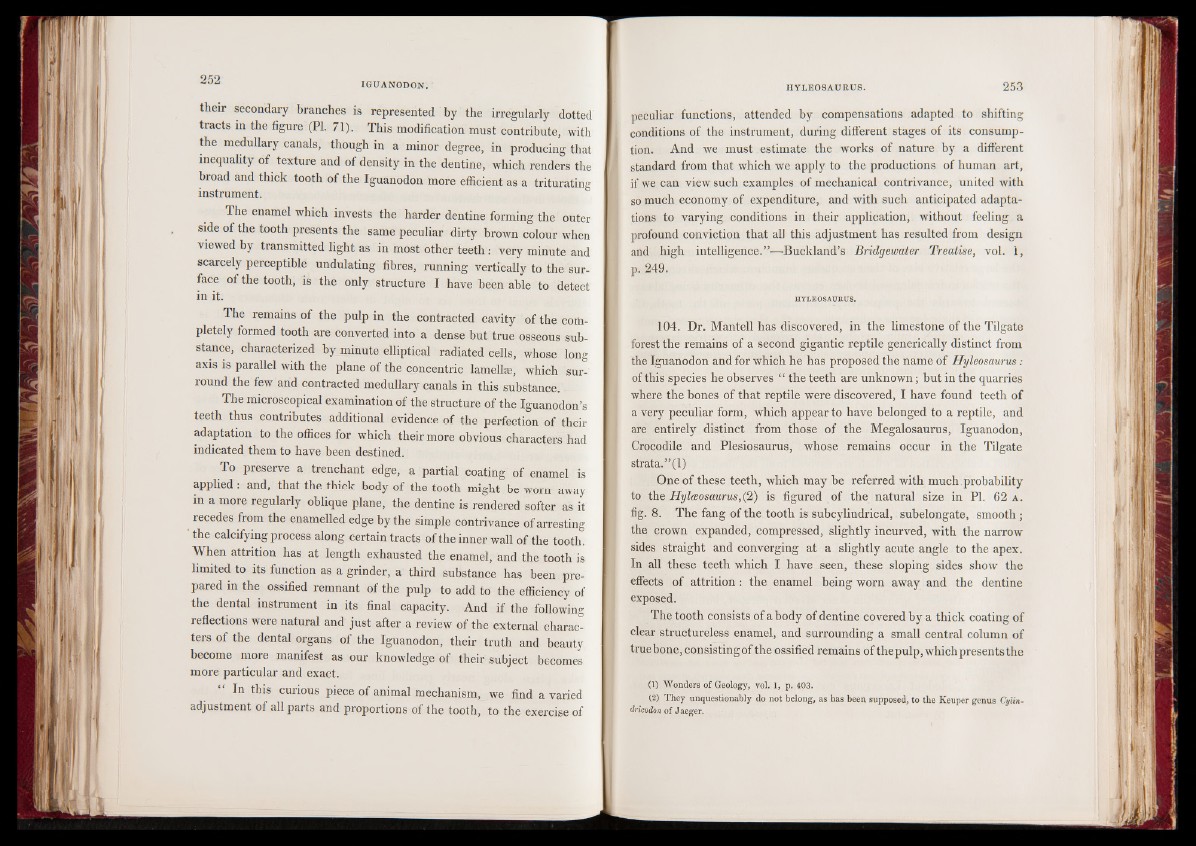
their secondary branches is represented by the irregularly dotted
tracts in the figure (PI. 71). This modification must contribute, with
the medullary canals, though in a minor degree, in producing that
inequality of texture and of density in the dentine, which renders the
broad and thick tooth of the Iguanodon more efficient as a triturating
instrument.
The enamel which invests the harder dentine forming the outer
side of the tooth presents the same peculiar dirty brown colour when
viewed by transmitted light as in most other teeth 1 very minute and
scarcely perceptible undulating fibres, running vertically to the surface
of the tooth, is the only structure I have been able to detect
in it.
The remains of the pulp in the contracted cavity of the completely
formed tooth are converted into a dense but true osseous substance,
characterized by minute elliptical radiated cells, whose long
axis is parallel with the plane of the concentric lamellae, which surround
the few and contracted medullary canals in this substance.
The microscopical examination of the structure of the Iguanodon’s
teeth thus contributes additional evidence of the perfection of their
adaptation to the offices for which their more obvious characters had
indicated them to have been destined.
To preserve a trenchant edge, a partial coating of enamel is
applied . and, that the thick body of the tooth might be worn away
in a more regularly oblique plane, the dentine is rendered softer as it
recedes from the enamelled edge by the simple contrivance of arresting
the calcifying process along certain tracts of the inner wall of the tooth.
When attrition has at length exhausted the enamel, and the tooth is
limited to its function as a grinder, a third substance has been prepared
in the ossified remnant of the pulp to add to the efficiency of
the dental instrument in its final capacity. And if the following
reflections were natural and just after a review of the external characters
of the dental organs of the Iguanodon, their truth and beauty
become more manifest as our knowledge of their subject becomes
more particular and exact.
In this curious piece of animal mechanism, we find a varied
adjustment of all parts and proportions of the tooth, to the exercise of
peculiar functions, attended by compensations adapted to shifting
conditions of the instrument, during different stages of its consumption.
And we must estimate the works of nature by a different
standard from that which we apply to the productions of human art,
if we can view such examples of mechanical contrivance, united with
so much economy of expenditure, and with such anticipated adaptations
to varying conditions in their application, without feeling a
profound conviction that all this adjustment has resulted from design
and high intelligence.”—Buckland’s Bridgewater Treatise, vol. 1,
p. 249.
HYLEOSAURUS.
104. Dr. Mantell has discovered, in the limestone of the Tilgate
forest the remains of a second gigantic reptile generically distinct from
the Iguanodon and for which he has proposed the name of Hyleosaurus :
of this species he observes “ the teeth are unknown; but in the quarries
where the bones of that reptile were discovered, I have found teeth of
a very peculiar form, which appear to have belonged to a reptile, and
are entirely distinct from those of the Megalosaurus, Iguanodon,
Crocodile and Plesiosaurus, whose remains occur in the Tilgate
strata. ”(1)
One of these teeth, which may be referred with much , probability
to the Hylceosaurus,{2) is figured of the natural size in PI. 62 a .
fig. 8. The fang of the tooth is subcylindrical, subelongate, smooth ;
the crown expanded, compressed, slightly incurved, with the narrow
sides straight and converging at a slightly acute angle to the apex.
In all these teeth which I have seen, these sloping sides show the
effects of attrition: the enamel being worn away and the dentine
exposed.
The tooth consists of a body of dentine covered by a thick coating of
clear structureless enamel, and surrounding a small central column of
true bone, consisting of the ossified remains of thepulp, which presents the
(1) Wonders of Geology, vol. 1, p. 403.
(2) They unquestionably do not belong, as has been supposed, to the Keuper genus Cylin-
dricodon of Jaeger.